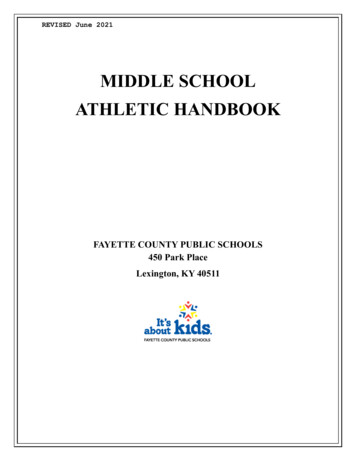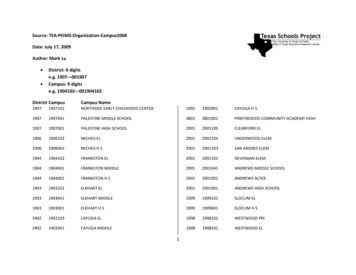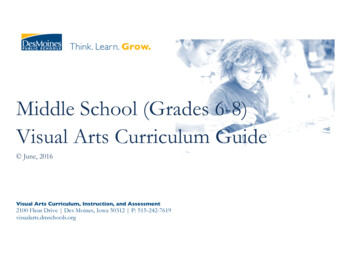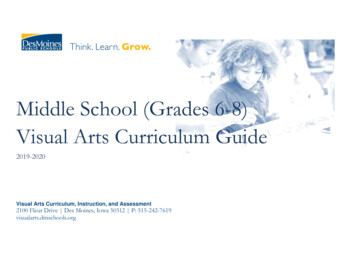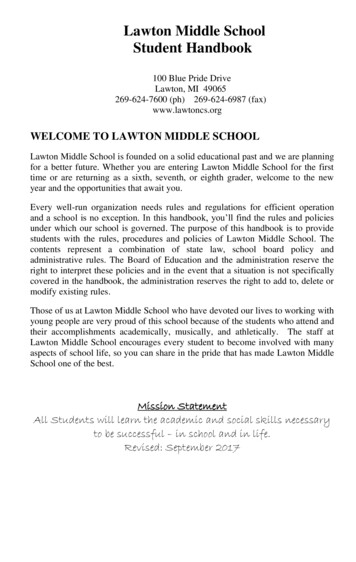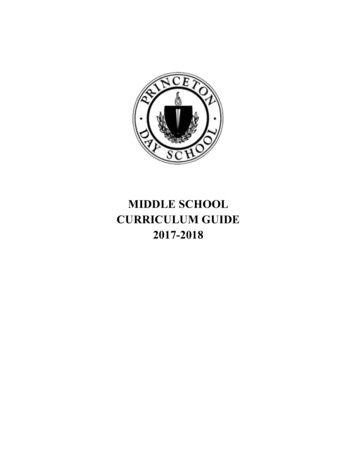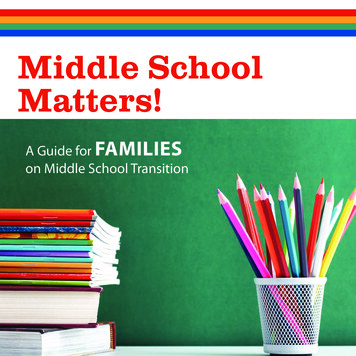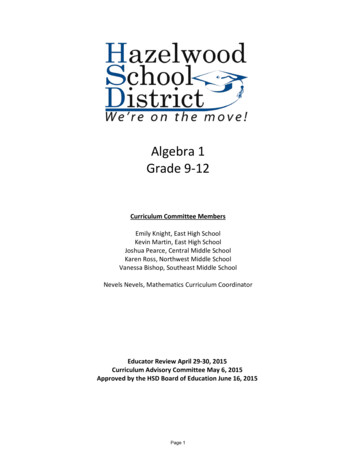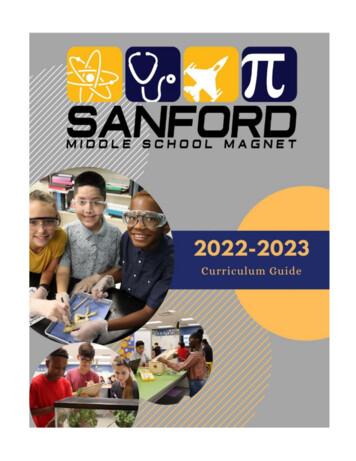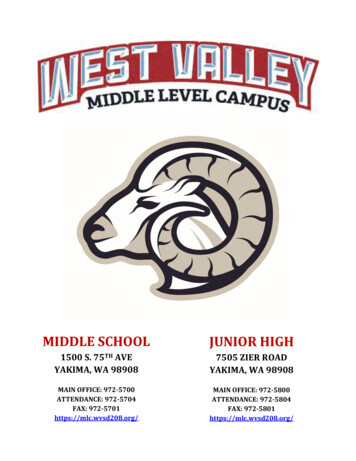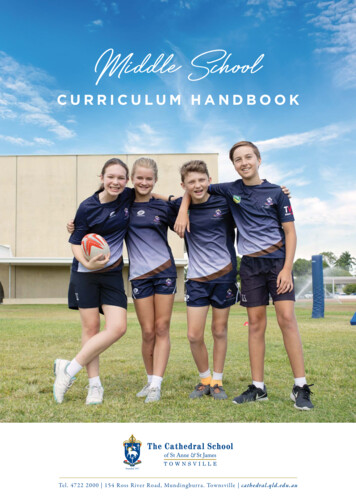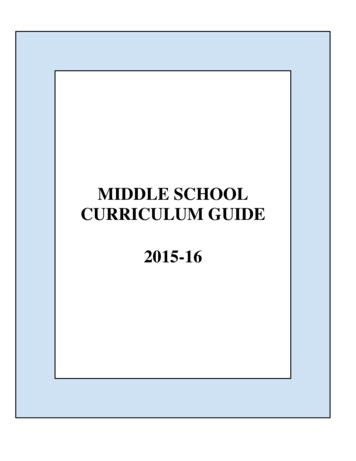
Transcription
MIDDLE SCHOOLCURRICULUM GUIDE2015-16
THE BLAKE MIDDLE SCHOOL - CURRICULUM GUIDE 2015-16MIDDLE SCHOOL MISSION STATEMENTThe Mission of the Blake Middle School is to inspire enthusiasm for learning and to nourish each adolescent’s intellectual and emotionaldevelopment in a supportive and diverse community grounded in the values of honesty, acceptance, respect, responsibility, and trust. Ourprogram and strong partnership among students, parents, and faculty will empower our middle school students to become well-rounded,lifelong learners who are able to see through multiple perspectives in order to understand and improve their world .OBJECTIVESTHE SCHOOL CLIMATEBased upon respect for the uniqueness and potential of each student, the Blake School will maintain a supportive community inwhich a unified and coherent academic and non-academic program functions. We will: Foster a positive self-concept, emotional maturity, personal integrity, a sense of responsibility and respect for others. Create open relationships between students and teachers. Make possible the development of mutual cooperation and a healthy attitude toward competition. Contribute a sense of tradition and continuity. Support risk-taking. Strengthen moral and civic values. Build high standards of conduct. Enhance aesthetic understanding.Within this climate, attainment of the following major objectives is possible:ACADEMIC EXCELLENCEOur tradition of academic excellence will be maintained and furthered by the attainment of objectives in the following areas Student Body: The Blake School will seek and maintain a diverse student body made up of students with highacademic potential and many individual strengths. Faculty and Administration: The Blake School will attract and retain a superior, highly qualified and diverseteaching staff and administration who are committed to the school’s goals. Curriculum: The curriculum will challenge all students to strive for excellence and attain their highest potentialthrough an integrated, sequential, and age-appropriate curriculum of skills, knowledge and values. Athletics and other Co-Curricular Activities: These programs will complement the academic program whileemphasizing group effort and cooperation, as well as encouraging participation and the development of individualskills. Resources: The Blake School will provide adequate resources to support the previous four areas.DIVERSITYThe school will acknowledge and cultivate the uniqueness and potential of each person in the school community. Each person in the school community appreciates and will be appreciated for his/her own uniqueness and potentialthrough both individual and group experiences. Each person will appreciate the positive value of diversity in our community. The school will develop programs that benefit our diverse community.WORTH OF THE INDIVIDUAL STUDENTThe School will help students achieve a positive self-concept and will recognize and accept their potential and limitations. The student will demonstrate self-awareness. The student will develop and use interpersonal and group interaction skills. The student will demonstrate self-confidence.EDUCATIONAL LEADERSHIPThrough climate student body, curriculum, and faculty and administration, the school will provide leadership within the greater public andindependent education community. The student body will distinguish itself through scholarship, accomplishments, and community involvement. The curriculum, evaluated on an annual basis, will incorporate what is best in educational theory. The administration and faculty will take initiative in developing and offering unique programs and/or educational approachesboth within the school and to the wider community.
GRADE LEVEL TEAMSThe Middle School is divided into three grade level teams. The teachers in each team meet together twice a week to discuss both academicand social issues pertinent to the class as a whole and/or individual students. The advisor serves as an advisor and advocate for the student.The advisor collects appropriate input about the student and is the first source of contact for the parent(s) for general academic or socialconcerns. The annual camping trips/outings, as well as the weekly meetings, are grade level oriented and designed to support our mission.The contents of this curriculum guide are designed to give an overview of the Blake Middle School courses, their objectives and contents.The Middle School is organized in both a grade level and departmental manner. The healthy balance of these two enables us to have astrong curriculum, while paying close attention to the total personality of the individual student. All the departments work within theframework of the Blake School’s philosophy and objectives and the Middle School philosophy. The philosophy and objectives andDivision Goals are followed by the courses in the departments that make up the Middle School curriculum:English/HumanitiesStudio & Performing ArtsMathematicsModern & Classical LanguagesPhysical EducationScienceSocial StudiesPages 4-8Pages 9-12Pages 12-16Pages 16-18Pages 18-20Pages 20-22Pages 22-23There are also two special departments in the Middle School:Student Services:Counseling & Learning SupportInformation ServicesPages 24-25Page 26-27
ENGLISHI.ACADEMICSThe broad goals of the English Department are development and improvement of the students’ reading, writing, speaking,listening, and media literacy skills. Teachers help students achieve these goals by a variety of methods ranging from directclassroom teaching to individualized instruction. Skills are taught and retaught when necessary. Teachers and students set thehighest possible standards.A. Students develop skills in reading through materials appropriate and challenging to age and abilityB. Students develop critical thinking through study of, discussion of, and written response to literatureC. Students develop a life-long enthusiasm for readingD. Students have frequent writing experiences, both expository and creative, in which clarity and effectiveness ofexpression are stressedE. Students are exposed to and practice proper grammar and usageF. Students develop speaking skills through formal presentations and informal discussionsG. Students learn to use multimedia materials for research, outside reading, and relevant class projectsH. Students learn to craft and support an argument and to identify the elements of rhetoric in nonfiction selectionsII.RESPONSIBILITYA.B.C.D.Students accept responsibility to improve their English achievement. Students will use class and tutorial timeappropriatelyIn small groups students share their ideas and respond constructively to othersStudents, with parent support, accept responsibility for regular class attendance and deadlinesStudents have the opportunity to pursue individualized assignments, independent work, or research projects, based ontheir ability and interestGRADE 6 HUMANITIESThe overall goal of this course is to develop global competency. In pursuit of this, we will examine global issues, develop and practiceresearch skills, nurture solid writing skills, and teach critical reading and comprehension, and explicitly teach and practice critical andcreative thinking. We will also use the Word Voyage program for vocabulary study.I.CRITICAL AND CREATIVE THINKINGA.B.C.II.Objectivesi.Ask critical, open-ended questions that help clarify and better understand a topicii.Identify root causesiii.Draw conclusions from dataiv.Understand biasv.Form opinions based on exploration and evidencevi.Attack difficult problemsvii.Think like an innovator – create a system or object that solves a problemviii.Seek creative solutions for social changeix.Understand how the past impacts the present to make predictions about the futureCourse Topicsi.Developmentii.Human Rightsiii.Peace and Securityiv.Humanitarian AffairsTexts and Materialsi.Current, relevant texts gleaned from a variety of print and web-based sourcesCOMMUNICATION AND PARTICIPATIONA.Objectivesi.Use a reading/article/text for class discussionii.Present ideas in a logical, appropriate fashioniii.Support ideas with evidence from the textiv.Discuss literature in a meaningful wayv.Participate effectively in literature circlesvi.Develop writing fluency/staminavii.Respectfully debate points and change opinions based on logical evidenceviii.Participate responsibly in small group work
ix.x.xi.xii.B.III.RESEARCH SKILLSA.B.IV.B.Objectivesi.Identify parts of speechii.Identify parts of a sentenceiii.Use correct punctuationiv.Identify and construct proper agreementTextsi.Rules of the Game Book I by Page, Guthrie and Sableii.Selections from Everyday Editing and Mechanically Inclined, both by Jeff AndersonVOCABULARYA.B.VII.Objectivesi.Summarize reading materialii.Take clear, logical notesiii.Manage your timeiv.Use an organizational system to keep a record of learningv.Put information provided by a teacher or article into their own wordsvi.Determine the main idea of an articleGRAMMAR, MECHANICS, AND USAGEA.VI.Objectivesi.Identify how to learn about various topicsii.Use available resources to answer questionsiii.Read more complex material, both fiction and nonfictioniv.Seek out multiple perspectivesv.Determine the main idea of an articlevi.Formulate thesis statements/identify a problemvii.Evaluate reliability of sourcesviii.Analyze primary and secondary sourcesix.Gather information from a variety of sourcesx.Paraphrase, summarize and directly quote from a source and know when to use which methodCourse Topicsi.World Savvy Challengeii.Bias and Slantiii.Country StudiesNOTE-TAKING, ORGANIZATION & STUDY SKILLSA.V.Contribute positively to class discussionListen activelyAssume good intentInteract, collaborate, and publish with peers, experts, or others employing a variety of digital environmentsand mediaxiii.Communicate information and ideas effectively to multiple audiences using a variety of media and formatsxiv.Develop cultural understanding and global awareness by engaging with learners of other culturesxv.Contribute to project teams to produce original works or solve problemsCourse ebateObjectivesi.Analyze context clues.ii.Increase vocabulary comprehension and usageiii.Use word attack strategies to explore and learn vocabularyTexts and Materialsi.Word lists drawn from class readings individualized word studyREADINGA.Objectivesi.Predictii.Visualize
Make inferencesIdentify main ideas in an articleApply a range of comprehension strategiesIdentify story elementsIdentify and explore themes in literature and lifeIncreased reading comprehensionMake connections T-T, T-S, T-WRead a novel and identify literary elementsCircuit, Francisco JiménezAbsolutely Almost, Lisa GraffThe Giver, Divergent, and The Lightening DreamerAdditional texts that reflect group and individual student interests & various short stories and poemsWRITINGA.Objectivesi.Expositorya) write a well-organized paragraph with a topic sentence, body and conclusionb) support an argumentc) write strong topic sentencesd) write thesis statementse) use knowledge of parts of speech to write varied sentence structuresii.Creativea) use indirect characterization to reveal a characterb) write in various genresGRADE 7I.READING/LITERATUREA.B.C.II.Objectives1. Develop comprehension skills2. Identify various genres and artistic forms3. Apply literary terms4. Explore values and themes through literature and life5. Develop discussion and listening skills through study of literature6. Continue to practice independent reading7. Apply methods of annotation to prepare for discussion and recognize themesCourse Topics1. Genre study2. Review of comprehension skills including visualization, summary, prediction, making inferences andconnections3. Behaviors to look for in discussionTexts and Materials1. Of Mice and Men by John Steinbeck2. Animal Farm by George Orwell3. Literature Circle texts around the theme of U.S. immigration4. Various short stories and poemsCOMPOSITIONA.Objectives1. Write frequently2. Write clearly and competently for a variety of purposes and in a variety of forms3. Work towards mastery of the revising and editing process4. Develop ability to make judgments about what constitutes good writing5. Write freely and creatively; journals6. Use an appropriate medium for publication and sharing7. Develop confidence in sharing original work
B.III.GRAMMARA.B.IV.B.Objectives1. Use work attack strategies to master new words2. Increase vocabulary comprehension and usageText and Materials1. Word lists drawn from class readings individualized word studyRESEARCH SKILLSA.VI.Objectives1. Understand the principles of grammar, usage and mechanics2. Apply these principles to student writing3. Course Topics4. Parts of speech5. Capitalization6. Use of commas and end marks7. Use of apostrophes8. Use of verbs9. Sentence structure10. Paragraph structureTexts and Materials1. The Writer’s Craft2. Grammar for Middle School – Kilgallon3. Rules of the Game – Page, Guthrie, and Sable4. Everyday Editing and Mechanically Inclined – Jeff AndersonVOCABULARYA.V.Course Topics1. Possible forms of writinga) paragraphsb) analytical essaysc) personal essaysd) book reportse) short storiesf) poetryg) persuasive speechesh) advertising techniques2. Skillsa) topic sentenceb) substantiation of topic sentencec) single-word and phrase transitionsd) mechanicse) sentence structure (fragments and run-on sentencesObjectives1. Develop proficiency at using online databases2. Use a variety of web-based sources to find and appropriately use information3. Evaluate the quality of an online sourceMEDIA LITERACY: BOOKS TO FILMA.Objectives1. Examine specific aspects of filmmaking2. Compare a specific book with a film version paying close attention to directorial choices
GRADE .Objectives1. Write in various genres including essays, poetry and memoir2. Support an argument with quotations from a text3. Write and deliver a persuasive speech4. Write for authentic purposes and audiences5. Develop writing conventions (mechanics, usage, punctuation, spelling)Course Skills1. Utilize all stages of the writing process (brainstorming, outlining, drafting, editing and revising)2. Develop a thesis statement3. Support claims with evidence4. Use of single-word and phrase transitions5. Develop sentence variety6. Develop an authentic purpose for each piece of writing7. Organization and fluidity of writing within each composition8. Establishing clear tone through precise dictionText and Materials1. Sentence Composing for Middle School, KilgallonVOCABULARYA.B.C.IV.Objectives1. Analyze and interpret literature in various genres2. Identify literary concepts in significant writings3. Read with increasing comprehension4. Encourage independent reading5. Learn to actively participate in discussions using textual evidenceCourse Topics1. Short story2. Poem3. Novel4. MemoirTexts and Materials1. Night, Elie Wiesel2. To Kill a Mockingbird, Harper Lee3. The Absolutely True Diary of a Part-Time Indian, Sherman Alexie4. Leaving Home, Hazel Rochman and Darlene McCampbell, eds.Objectives1. Understand, learn and use high frequency, academic and conceptual words found in our texts2. Practice using words in writing assignments3. Use context clues and analyze word partsCourse Topics1. Etymology2. Dictionary skills3. Use of thesaurusTexts and Materials1. Longman Dictionary of American English2. Webster’s New World Roget’s A-Z Thesaurus3. Word lists drawn from class readings individualized word studyRESEARCH SKILLSA.Objectives1. Develop proficiency at using online databases2. Use a variety of web-based sources to find and appropriately use information3. Evaluate the quality of an online source4. Take notes in point form5. Reference sources appropriately
STUDIO & PERFORMING ARTSThe arts engage students in expression through study, dialogue, exploration, performance, evaluation and exhibition of personal andprofessional artworks. We call on our students to develop a language of the creative spirit and a facility for critical thinking.SEQUENCE & STRUCTURE OF BLAKE MIDDLE SCHOOL ART CLASSESBlake Middle School offers three branches of music--Band, Choir and Strings--and three art disciplines--Theatre, Visual Art and WoodStudio. All students meet twice weekly in their elected music class for the entire year, and twice weekly in their arts disciplines. The artclasses rotate at the trimester in 6th grade and at the semester in 7th and 8th grade. Each 6th grade student is required to take Theatre,Visual Art and Wood Studio. The class meets twice a week for a trimester. At the end of a trimester the student will change to the nextclass in the rotation. In the 7th grade, students continue with their music class and elect two arts choices. They will be in each artdiscipline for one semester. In 8th grade, students may continue to elect one music and two arts choices for the year, OR they may applyfor the Integrated Arts course. Students are accepted to Integrated Arts through an application and interview process to this course whichmeets four days each week for the entire year and combines the study of Theatre, Visual Art, Wood Studio, and Music.VISUAL ARTOVERVIEWThe Middle School Visual Art program builds upon art skills and knowledge acquired in Lower School, focusing on developing student’sabilities to see and perceive through the lens of an artist. Students develop technical skills while honoring their own style and creativevoice. Basic techniques and styles of drawing, painting and 3D works will be taught through variety of media and through specificexercises and assignments meant to build a solid foundation for arts classes at the Upper School. Each class features student centered,project based learning chosen from units that include drawing, painting, ceramics and mixed media. Students will learn a workingknowledge of art vocabulary and specific history of art from diverse cultural and stylistic perspectives. Students are also encouraged toexperiment and explore all aspect of art; its processes, history, movement and, engaged in hands-on projects designed for self-expression.ART 6Sixth grade visual art provides student the opportunity to acquire basic drawing techniques and skills touching on art knowledgeand exploring the elements of art. Sixth grade art meets twice a week for a trimester. All 6th grade students will have Art as partof their Arts rotation, which also includes Theatre and Wood Shop.ART 7/8 A (next offered in 2015-2016)Units are chosen from drawing, painting, and 3D works. This class further develops skills introduced during 6th grade. Much ofour study is of expressive and emotional qualities in art. Art 7/8 meets twice a week for a semester.ART 7/8 B (next offered in 2016-2017)In Art 7/8 B, our study includes technical skills, methods and styles in art. Projects include perspective drawing, drafting andarchitecture, pinhole photography, extruded clay forms and work on the potter’s wheel, digital art, designing your own currency,human anatomy and gesture drawing and some new styles of painting. Art 7/8 meets twice a week for a semester.THEATREOVERVIEWThe Theatre program in the Middle School is designed to give each student exposure to a variety of facets in theatre including pantomime,improvisation, playwriting, theatre history, and beginning acting techniques.CREATIVE DRAMA 6Students begin the trimester using pantomime to bring stories and poems, as well as original plots and characters, to life.Pantomime allows students to concentrate on movement and facial expression in their early-improvised performances. As thetrimester progresses, students add voice and oral expression to their daily performances as they dig deeper into developing theircharacters and plots. Students learn and use the nine basic stage areas, as well as the different types of stages used in theatrearchitecture.YEAR A: BEGINNING ACTING 7/8 (next offered in 2015-2016)In this semester course, each quarter begins with a series of improvisation activities/exercises, which help student actors furtherbuild their theatrical performance skills. As well, students choose and perform a role in a scene, the first in a short modern scene,and the second in a classic text scene from Shakespeare’s A Midsummer Night’s Dream. Students work together in pairs or smallgroups to: develop their characters and convey their objectives, block action and create interesting stage business, memorizelines, and add necessary technical elements to bring their scene to life. Throughout the rehearsal process, actors receivecoaching and constructive critique from their peers and the instructor. At the end of each quarter, students watch their final sceneson film and assess their own performances.YEAR B: PERFORMANCE & PLAYWRITING 7/8 (next offered in 2016-2017)
In this semester course, students learn the basic steps necessary to craft a play. Using both acting improvisation and writingexercises, students write and perform their way through numerous scenes during the semester. Each quarter, they work asindividual playwrights and in small groups, to create interesting characters and plots as they learn the basic components ofbuilding a script (character, motivation, conflict, resolution, plot, spectacle, etc.). Plays, however, were never meant to remain onthe page; they beg to be performed. With that in mind, each original student scene is showcased in front of the class, allowingyoung playwrights to act in their peers’ works, as well as see their own plots and characters brought to life by their classmates.CHORAL MUSICOVERVIEWThe Middle School choral program focuses on a three-year curriculum in which singers study and perform music that represents diversechoral traditions throughout the world, including sacred and secular styles, and reflecting historical periods spanning the Renaissancethrough contemporary works.CHORUS 6 (Grade 6, Mixed Ensemble, mostly treble range)Chorus 6 rehearses twice a week for the entire year. Students develop their musicianship through unison and part songs designedto solidify the skills necessary for singing in two or more parts. Music is chosen to fit the particular voicing of the choir. Sightsinging and ear-training using solfege nurture essential skills for performing music. The Chorus 6 rehearses in two differentsections but they perform together as a whole ensemble at two choral concerts per year. Concerts are held in the MPAC.7/8 GENDER-SPECIFIC CHOIRSBOYCHOIR (Male Ensemble) or TREBLE CHOIR (Female Ensemble)Students enrolled in either BoyChoir or Treble Choir rehearse twice a week for the entire year. Students continue to expand theirmusical skills by focusing on music and vocal techniques specific to a single gender. Attention is given to the care and use of thedeveloping voice that the students will experience during the next several years. Music is chosen to fit the particular voicing ofthe choir, which includes a wider range of ability levels and changed, changing, or unchanged voices. Special consideration isgiven to choosing repertoire that develops musicianship and showcases the maturing adolescent voice. Sight singing and eartraining techniques focus on building skills needed to perform more complex music. BoyChoir and Treble Choir perform at twoconcerts per year, held in the MPAC.7/8 MIXED-VOICED CHOIRSCONCERT CHOIR or CHORISTERSStudents enrolled in either Concert Choir or Choristers rehearse twice a week for the entire year. Both choirs perform in multipleparts and move more quickly through material than gender-specific choirs, due to overall skill and vocal development. Placementin either choir is based on skill level and aptitude determined by rehearsal work and assessments done during the previous year,and for some students, also a spring placement audition. Music is chosen to fit the particular voicing of the choir that usuallyincludes soprano, alto, tenor, and baritone parts. Repertoire builds knowledge of choral performance practices among many stylesof music. Sight singing and ear-training techniques focus on building skills needed to perform more complex music, includinga cappella (unaccompanied) works. Occasionally, singers may be required to attend an additional rehearsal during Tutorial.Concert Choir and Choristers typically perform two concerts per year, held in the MPAC.TUTORIAL ENSEMBLES & HONOR CHOIRS (determined by interest, ability and schedule).Students may volunteer to participate in enrichment activities during Tutorial, which develop individual or small group singing skills.Those students interested in auditioning for a state, regional, or national honor choir need to complete audition requirements in general bySeptember 25th of each year. See Mr. LeJeune for more information or check Moodle.INSTRUMENTAL MUSICOVERVIEWThe Middle School instrumental music program focuses on developing students’ ensemble, expressive, and technical skills through largegroup rehearsals and small-group sectional lessons. Both experienced and beginning instrumentalists grow in the areas of focus, discipline,and teamwork while studying and performing repertoire covering a variety of periods and styles.BAND 6Band 6, open to all sixth graders, is the beginning band at Blake. It rehearses two times a week over the entire year. Additionally,each student will be scheduled for a weekly small-group lesson. Band 6 performs at least twice a year. Band 6 is where thestudent learns instrumental fundamentals and ensemble techniques. Various written and aural experiences will be used tointroduce and reinforce the fundamentals of music and music performance. Each student will prepare and perform a solo for theannual solo festival. With the exception of French horn, tuba, and euphonium players, each student is required to furnish his/herown instrument and related accessories.CONCERT BAND (Grades 7 & 8)The Concert Band experience focuses on stretching musical skills and understanding through practice and performance. Concert
Band performs at least twice during the year. Two weekly rehearsals are complemented by weekly small-group lessons.Complementary activities may include Jazz Lab, solos and ensembles and guest conductor/clinicians. Placement in ConcertBand is by the instructor, based on ability level, past performance and record of consistent and positive rehearsal contribution.Band students are required to furnish their own instrument and related accessories. Students are encouraged to study privatelyoutside of school.WIND ENSEMBLE (Grades 7 & 8)The Wind Ensemble is an accelerated instrumental ensemble that plays more challenging repertoire representative of the highestquality literature for young bands. The Wind Ensemble rehearses two times every week all year. Rehearsals are complemented byweekly small-group lessons. The Wind Ensemble performs at least twice during the academic year. The emphasis on increasedmusicality and performance technique is reflected in heightened expectations of the student musicians. Complementary activitiesmay include Jazz Lab, solos and ensembles, and guest conductor/clinicians. Placement in Wind Ensemble is by the instructorbased on ability level, past performance and record of consistent and positive rehearsal contribution. Students are required tofurnish their own instrument and related accessories. Wind Ensemble students are strongly encouraged to study privately outsideof school.ORCHESTRASTRINGS 6Strings 6, open to sixth graders, is composed primarily of students with previous experience on a stringed instrument (violin,viola, cello, bass). It rehearses two times a week over the entire year. Additionally, each student will be scheduled for a weeklysmall-group lesson. Strings 6 performs at least twice a year. Various written and aural experiences will be used to developtechnical, literacy and ensemble skills. Each student will prepare and perform a solo for the annual solo festival. Strings studentsare required to furnish their own instrument and related accessories.STRING ORCHESTRA (Grade 7 & 8)String Orchestra rehearses twice a week for the entire year and is open to 7th & 8th grade students who have previous experienceon violin, viola, cello, or string bass. Students will continue to develop their technical, literacy, and ensemble skills in both largegroup rehearsals and small-group lessons. A variety of musical periods and styles is covered. Strings students are required tofurnish their own instrument and related accessories. String Orchestra will perform at the Winter and Spring concerts. Placementin String Orchestra is done by the instructor and is based on ability level, past performance and a record of consistent and positiverehearsal contribution. Students are encouraged to study privately outside of school.CHAMBER STRINGS (Grade 7 & 8)Chamber Strings is an accelerated ensemble that rehearses twice a week for the entire year and is open to 7th & 8th gradestudents who have previous experience on violin, viola, cello, or string bass. This course allows students to experience repertoirefrom the common practice periods (Baroque, Classical, Romantic, and Contemporary) and gain a rich knowledge of theperformance practices through in-depth study, reflected in high rehearsal and home-practice expectations. Students are requiredto furnish their own instrument and related accessories. Chamber Strings will perform at the Winter and Spring concerts.Placement in Chamber String is done by the instructor and is based on ability level, past performance and a record of consistentand positive rehearsal contribution. Chamber Strings students are strongly encouraged to study privately outside of school.WOOD STUDIOOVERVIEWIntroduction to wood and alternative materials as a design medium. Design and cre
framework of the Blake School's philosophy and objectives and the Middle School philosophy. The philosophy and objectives and Division Goals are followed by the courses in the departments that make up the Middle School curriculum: English/Humanities Pages 4-8 Studio & Performing Arts Pages 9-12 Mathematics Pages 12-16
